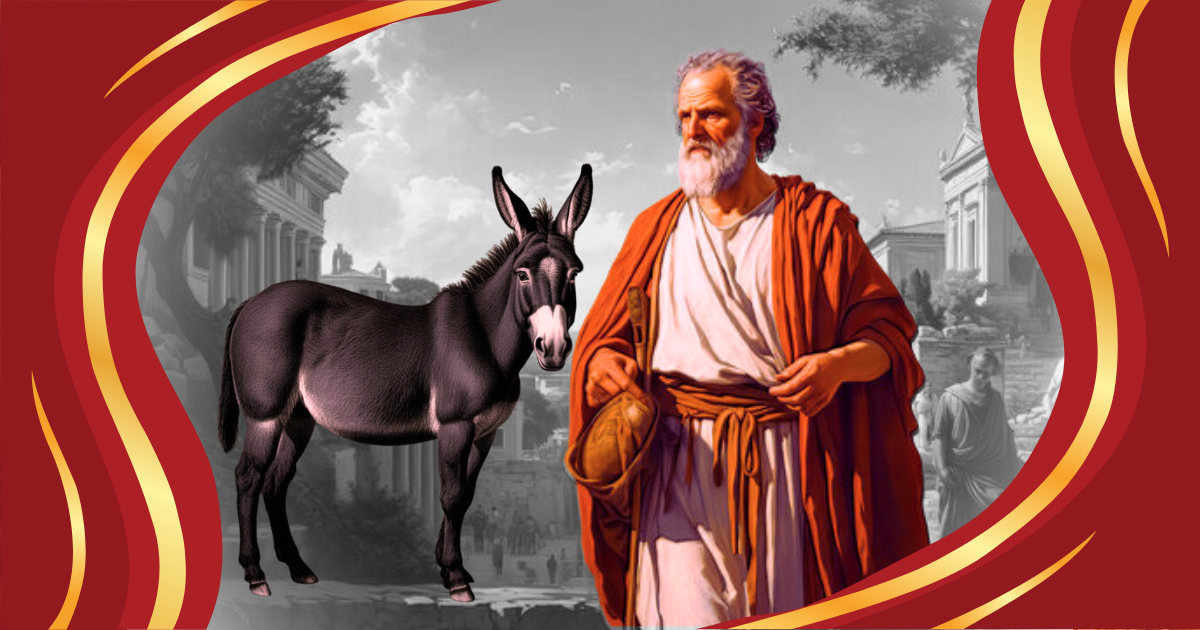Aristotle, one of the most renowned philosophers in history, contributed extensively to various fields including philosophy, biology, and natural science. His work, though groundbreaking, has also been the subject of historical debates and controversies. One of the more curious debates centers on whether Aristotle examined Aristotle teeth in a donkey jaw to support his observations on human and animal anatomy. This post explores 5 fascinating facts about Aristotle’s debate over teeth and how a donkey jaw became involved in his scientific observations.
Who Was Aristotle? Exploring His Contributions to Science and Philosophy
Before diving into the debate about Aristotle and the teeth in a donkey jaw, it’s important to understand who Aristotle was and the significance of his contributions. Born in 384 BCE in Stagira, Greece, Aristotle became a student of Plato and later went on to teach Alexander the Great. He made profound contributions in various disciplines, establishing himself as a foundational figure in Western thought.
Aristotle’s Influence on Philosophy and Science
Aristotle’s philosophy covered many areas including ethics, politics, metaphysics, and natural science. His scientific method, which emphasized observation and logical reasoning, laid the groundwork for future scientific inquiry. In the realm of biology, he was among the first to observe and categorize living organisms, earning him the title of the “father of biology.”
One of Aristotle’s key interests was anatomy, and he dedicated time to studying both humans and animals. According to historical accounts, there is a debate about whether Aristotle observed teeth in a donkey jaw to draw conclusions about the anatomical differences between animals and humans. Some records suggest that Aristotle examined various animal bones to compare their structures, leading to the hypothesis that he may have used a donkey jaw to study teeth formation.
1. Aristotle’s Study of Teeth
In his biological works, Aristotle discussed teeth in detail, especially the distinction between humans and other animals. He observed that humans have a unique set of incisors and molars, which set them apart from animals like donkeys. Whether Aristotle used a donkey’s jaw for these observations remains a point of contention, but the idea illustrates his hands-on approach to science.
2. Animal Anatomy as a Comparison
Aristotle was known to dissect and study various animals to better understand anatomy. His belief was that by comparing animal anatomy to humans, he could draw general conclusions about living beings. Whether or not the donkey jaw was part of his actual research, it symbolizes his commitment to empirical observation.
The Historical Debate: Did Aristotle Examine Teeth in a Donkey Jaw?
The debate over whether Aristotle examined teeth in a donkey jaw has intrigued historians and scholars alike. Although it is unclear if Aristotle specifically used a donkey jaw in his studies, the story may have evolved as a metaphor for his broader method of using comparative anatomy.
1. The Misinterpretation of Aristotle’s Work
Some scholars believe that Aristotle’s references to teeth and jaws in his biological works could have been misinterpreted over time. While Aristotle may not have explicitly examined a donkey’s jaw, the idea represents his exploration into how different species’ jaws and teeth functioned.
2. An Enduring Debate
Despite the lack of concrete evidence, this debate remains a testament to Aristotle’s role in the development of anatomical study. The donkey jaw continues to serve as an intriguing part of Aristotle’s legacy, symbolizing the lengths to which he went to understand the natural world.
Aristotle’s Contribution to Biology and Anatomy: What We Can Learn Today
Aristotle’s approach to biology and anatomy laid the foundation for future scientists and philosophers to build upon. His dedication to observational science and dissection allowed him to describe and document various biological phenomena, many of which are still studied today.
1. The First Comprehensive Biological Texts
Aristotle was one of the first thinkers to compile comprehensive biological texts that included classifications of animals, observations on reproduction, and anatomical descriptions. His work on animal biology helped future generations understand how different species function.
2. Relevance in Modern Biology
Today, Aristotle’s contributions to biology continue to influence modern scientific methods. Although modern science has advanced far beyond Aristotle’s initial observations, his method of combining observation with logical reasoning is still a foundational element in how scientists approach new research.
Why Did Aristotle’s Teeth Theory Cause Controversy in Ancient Greece?
Aristotle’s ideas, particularly his theories on anatomy and biology, were not always accepted in Ancient Greece. His ideas about teeth and human anatomy sparked controversy, particularly because they challenged some long-held beliefs of the time.
1. Skepticism from Contemporaries
Aristotle’s contemporaries, particularly those who adhered to Plato’s philosophy, were skeptical of his emphasis on empirical observation. Many philosophers of the time believed that pure reasoning, rather than hands-on observation, was the most reliable way to gain knowledge. Aristotle’s work on teeth, especially if he did use a donkey jaw for his studies, symbolized a break from tradition.
2. Challenging Conventional Wisdom
Aristotle’s conclusions about teeth and other anatomical features often contradicted the conventional wisdom of his time. His scientific method, which valued direct observation and dissection, was revolutionary but also controversial in an era where philosophical inquiry rarely involved direct interaction with the physical world.
The Role of Observation in Aristotle’s Scientific Method
One of Aristotle’s most important contributions to science was his emphasis on observation as a method of gaining knowledge. While many philosophers of his era relied heavily on abstract reasoning, Aristotle believed in the importance of direct observation of the natural world.
1. Hands-On Research
Aristotle’s use of hands-on research, whether through examining bones or conducting dissections, was groundbreaking. This approach allowed him to document and analyze various aspects of animal anatomy and human biology that had previously been neglected.
2. Observation and Logical Deduction
Aristotle’s approach combined observation with logical deduction, meaning that he didn’t just describe what he saw; he tried to understand why things happened the way they did. His observations about teeth and the jaws of animals, such as donkeys, led him to draw broader conclusions about anatomical differences between species.
The Importance of Skepticism: Aristotle’s Teeth in a Donkey Jaw and Its Legacy
Aristotle’s study of teeth and anatomy, whether or not it involved a donkey jaw, highlights an important aspect of scientific inquiry—skepticism. Aristotle’s work encouraged future scientists to question assumptions and verify theories through observation and experimentation.
1. Encouraging Skeptical Inquiry
Aristotle’s willingness to question conventional beliefs set the stage for a new era of scientific thinking. His emphasis on empirical evidence challenged scholars to adopt a more skeptical and methodical approach to studying the natural world.
2. Legacy in Modern Science
Today, the legacy of Aristotle’s methods can be seen in the scientific method, which relies on observation, hypothesis testing, and skepticism. Whether it’s examining a donkey jaw or investigating other natural phenomena, Aristotle’s influence on modern science is undeniable.
For more exciting blogs, visit our homepage Magzineco.
Conclusion: Aristotle’s Teeth in a Donkey Jaw – A Lesson in Scientific Inquiry
The story of Aristotle examining teeth in a donkey jaw may be part historical fact, part metaphor, but it serves as a reminder of the philosopher’s dedication to observational science. His willingness to challenge existing beliefs, rely on empirical observation, and promote skepticism in the pursuit of knowledge left an indelible mark on science and philosophy. While the debate continues, Aristotle’s commitment to understanding the natural world remains one of his most significant legacies.
FAQs About Aristotle and Teeth in a Donkey Jaw
- Did Aristotle really examine teeth in a donkey jaw?
It’s unclear whether Aristotle specifically examined a donkey jaw, but he did use comparative anatomy to study teeth and other body parts across different species. - Why did Aristotle study animal jaws and teeth?
Aristotle was interested in understanding the anatomical differences between species, and teeth provided insights into how animals adapt to their environments. - What contributions did Aristotle make to biology?
Aristotle is considered the “father of biology” due to his groundbreaking observations on anatomy, reproduction, and species classification. - Why was Aristotle’s scientific method controversial?
Aristotle’s emphasis on empirical observation challenged the traditional philosophical reliance on abstract reasoning, leading to skepticism from his contemporaries. - How did Aristotle’s observations on anatomy influence modern science?
Aristotle’s approach to studying biology through observation and dissection laid the groundwork for the development of the modern scientific method.
Why is the donkey jaw specifically mentioned in relation to Aristotle’s studies?
The donkey jaw became a symbolic part of the debate due to Aristotle’s emphasis on comparative anatomy, where he studied the jaws and teeth of various animals, possibly including donkeys, to draw conclusions about species differences.
What did Aristotle conclude about teeth in animals versus humans?
Aristotle noted that humans have distinct sets of incisors and molars, unlike some animals, and this difference relates to diet and function. He emphasized that the shape and structure of teeth reflect an animal’s behavior and feeding habits.
Did Aristotle dissect animals as part of his research?
Yes, Aristotle was known to dissect animals to understand their anatomy. His hands-on approach provided detailed insights into biological functions, setting him apart from philosophers who relied only on theoretical reasoning.
What was the significance of Aristotle’s anatomical studies for ancient science?
Aristotle’s work in anatomy helped lay the foundation for future scientific inquiry by emphasizing empirical observation and biological classification, making his contributions pivotal to the development of early biology.
How did Aristotle’s studies influence modern biology and anatomy?
Aristotle’s approach to studying the natural world through systematic observation and classification directly influenced the development of the scientific method used in modern biology, anatomy, and zoology.




